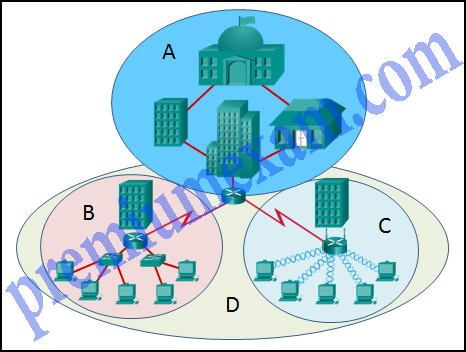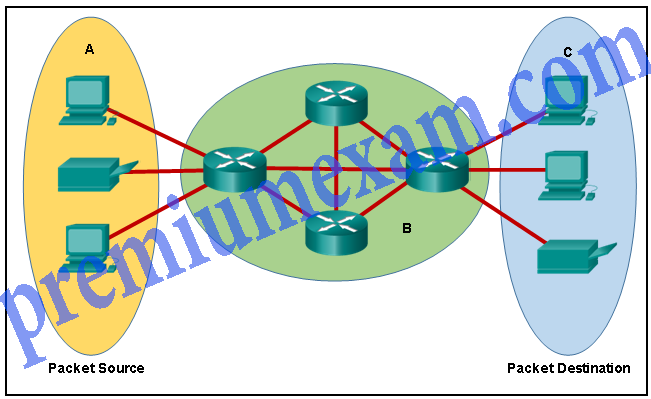Last Updated on January 28, 2021 by Admin
ITN Chapter 1 Quiz Answers Cisco 2019 100%
This quiz covers the content in CCNA R&S Introduction to Networks Chapter 1. It is designed to provide an additional opportunity to practice the skills and knowledge presented in the chapter and to prepare for the Chapter Exam.
-
Fill in the blank.
Refer to the exhibit. This represents an example of an internal security threat to an organization.
- Noted: The correct answers can be two : internal and inside in netacad, but in our online system you can use only internal.
Explanation: Typical internal security threats include weak or exposed passwords, lost or stolen devices, and malicious employees.
- Noted: The correct answers can be two : internal and inside in netacad, but in our online system you can use only internal.
-
What is a WAN?
- a network infrastructure designed to provide data storage, retrieval, and replication
- a network infrastructure that provides access to other networks over a large geographic area
- a network infrastructure that spans a limited physical area such as a city
- a network infrastructure that provides access in a small geographic area
Explanation: A WAN provides access to other networks over a large geographic area. A SAN provides data storage, retrieval, and replication. A MAN spans a limited physical area such as a city. A LAN provides access in a small geographic area.
-
Match the Internet connectivity type to the appropriate description or characteristic. (Not all options are used.)
- Metro Ethernet ——–> high-speed business class copper or fiber connection
- satellite ——-> requires a dish and clear line of sight for service
- SDSL ——-> business class service that provides the same upload and download speeds over telephone lines
- cable ———> signal carried on the same copper or fiber medium as the television signal
- cellular ——–> access via the cell phone network
Explanation: DSL uses a high-speed modem to split the existing telephone line into voice, download, and upload signal channels. SDSL is a format of DSL that provides business class service featuring the same speeds for uploading and downloading. Cable uses the same coaxial or fiber optic cable that carries television signals into the home to provide Internet access. Satellite requires a clear line of sight and is affected by trees and other obstructions. Cellular access to the internet is provided by the cell phone network. Cellular provides access in areas that otherwise have no other form of access. Metro Ethernet is a dedicated business class of service that connects organizations to the internet via copper or fiber cable at speeds up to 10Gb/s.
-
What are two characteristics of a scalable network? (Choose two.)
- easily overloaded with increased traffic
- grows in size without impacting existing users
- is not as reliable as a small network
- suitable for modular devices that allow for expansion
- offers limited number of applications
Explanation: Scalable networks are networks that can grow without requiring costly replacement of existing network devices. One way to make a network scalable is to buy networking devices that are modular.
-
Which three devices are considered end devices in a network? (Choose three.)
- router
- switch
- VoIP phone
- security camera
- access point
- TelePresence endpoint
Explanation: Routers, switches, and access points are intermediary devices.
-
Refer to the exhibit. Match the example networks to the type of network. (Not all options are used.)
- Network A ——–> MAN
- Network B ——–> LAN
- Network C ——–> WLAN
- Network D ——–> WAN
Explanation: Network A is a MAN. It consists of a number of different types of facilities that are connected within the same geographic area. Network B is a LAN. It is located in a limited geographic area in a single building. Network C is a WLAN. It is a LAN in which the devices are connected wirelessly. Finally option D shows a WAN. It is two geographically separate LANs that are connected to the same enterprise.
-
The arpanet project started the development of inter-network connections using TCP/IP that has evolved into the Internet today.
- Noted: The correct answers can be 4 : arpanet, ARPANET, Advanced Research Projects Agency Network, and Advanced Research Projects Agency in netacad, but in our online system you can use only arpanet.
-
How does BYOD change the way in which businesses implement networks?
- BYOD requires organizations to purchase laptops rather than desktops.
- BYOD users are responsible for their own network security, thus reducing the need for organizational security policies.
- BYOD devices are more expensive than devices that are purchased by an organization.
- BYOD provides flexibility in where and how users can access network resources.
Explanation: A BYOD environment requires an organization to accommodate a variety of devices and access methods. Personal devices, which are not under company control, may be involved, so security is critical. Onsite hardware costs will be reduced, allowing a business to focus on delivering collaboration tools and other software to BYOD users.
-
In which scenario would the use of a WISP be recommended?
- an Internet cafe in a city
- a farm in a rural area without wired broadband access
- any home with multiple wireless devices
- an apartment in a building with cable access to the Internet
Explanation: Wireless Internet Service Providers (WISPs) are typically found in rural areas where DSL or cable access is not available. A dish or antenna on the property of the subscriber connects wirelessly to a WISP transmitter, eliminating the need for physical cabling outside the building.
-
What is an ISP?
- It is a standards body that develops cabling and wiring standards for networking.
- It is a protocol that establishes how computers within a local network communicate.
- It is an organization that enables individuals and businesses to connect to the Internet.
- It is a networking device that combines the functionality of several different networking devices in one.
Explanation: An ISP, or Internet Service Provider, is an organization that provides access to the Internet for businesses and individuals.
-
A college is building a new dormitory on its campus. Workers are digging in the ground to install a new water pipe for the dormitory. A worker accidentally damages a fiber optic cable that connects two of the existing dormitories to the campus data center. Although the cable has been cut, students in the dormitories only experience a very short interruption of network services. What characteristic of the network is shown here?
- quality of service (QoS)
- scalability
- security
- fault tolerance
- integrity
Explanation: Fault tolerance is the characteristic of a network which allows it to quickly respond to failures of network devices, media, or services. Quality of service refers to the measures taken to ensure that network traffic requiring higher throughput receives the required network resources. Scalability refers to the ability of the network to grow to accommodate new requirements. Security refers to protecting networks and data from theft, alteration, or destruction. Integrity refers to the completeness of something and is generally not used as a characteristic of networks in the same way as the other terms.
-
Which statement describes a characteristic of a converged network?
- A single network that delivers voice, video, and data to a variety of devices.
- Network services are delivered over a wide range of network platforms.
- The network establishes separate communication channels for each network service.
- The network uses different technologies for voice, video, and data.
Explanation: A converged network unifies different network services, such as streaming video, voice, and data, on a single platform and within a single infrastructure.
-
During a routine inspection, a technician discovered that software that was installed on a computer was secretly collecting data about websites that were visited by users of the computer. Which type of threat is affecting this computer?
- DoS attack
- identity theft
- spyware
- zero-day attack
Explanation: Spyware is software that is installed on a network device and that collects information.
-
An employee wants to access the network of the organization remotely, in the safest possible way. What network feature would allow an employee to gain secure remote access to a company network?
- ACL
- IPS
- VPN
- BYOD
Explanation: Virtual private networks (VPN) are used to provide secure access to remote workers.
-
Refer to the exhibit. Which term correctly identifies the device type that is included in the area B?
- source
- end
- transfer
- intermediary
Explanation: Intranets connect LANs and WANs that should only be accessible by internal employees, whereas an extranet allows organizations to do business directly with other external organizations by allowing them access to part of the internal network.
-
Fill in the blank.
An Intranet is a private connection of LANs and WANs that belongs to an organization, and is designed to be accessible only by the members and employees of the organization, or others with authorization.
- Noted: The correct answers can be 7 : Intranet, intranet, Intra net, intra net, Intra-net, intra-net
, INTRANET in netacad, but in our online system you can use only Intranet.Explanation: Routers and switches are intermediary devices. End devices consist of PCs, laptops, and servers. They also include printers, VoIP phones, security cameras, and hand-held devices.
- Noted: The correct answers can be 7 : Intranet, intranet, Intra net, intra net, Intra-net, intra-net



